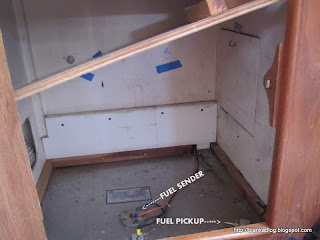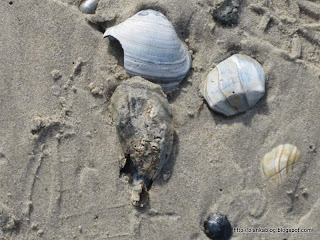If you've got a diesel engine on your boat you've probably got a fuel tank somewhere. It's probably tucked away in some out of the way place on your boat. If your are lucky you have an inspection port already installed. But, many if not most production boats do not. Why? Because it cost extra money and time for the builders to install it. But, if I were buying a new boat or even just buying a new fuel tank I would have one installed knowing what I know now. Follow Capt. Mike as he goes into the tank and you'll see why.
I stopped using and carrying diesel fuel on BIANKA three years ago. I drained the fuel tank as part of the conversion to electric propulsion. My ASMO MARINE electric propulsion system has no need of diesel fuel so the tank has been empty since the spring of 2008. This year I decided to start converting the empty unused diesel fuel tank on board into a fresh water rinse tank so that I could use the water to clean and rinse down the cockpit on extended days at anchor. That is if I can get it cleaned out enough.
Fuel tanks look like they have to meet some particular standards by the authorities if the label on BIANKA's is any indication:
For good reasons. The authorities really would rather not deal with too many boat fires and explosions. Rescues on the water are hard enough with boats that are not on fire or scattered into a thousand pieces all over the harbor. So these standards are a good thing.
The first step in the conversion process on BIANKA was to use an inspection camera to see if the tank had a baffle installed. This was important to know because I wanted to have an inspection port on the converted tank to inspect and be able to clean the inside of the tank easily. If there was a baffle in the tank it would limit my choices of where to install the inspection port. Happily, there was no baffle so that meant I could install the port where ever I wanted. I choose to place it roughly in the center of the tank. Since I would not be using the old diesel fuel sender anymore either I made sure that the hole cut for the inspection port would encompass the cutout for the defunct fuel sender port too. CAPT. MIKE NOTE: I will be posting about installing the inspection port in a later post. You can see the location I chose in the photo below:
After cutting the hole I was able to get a better look and more importantly better access to the inside of the tank. What I found was not pretty. The fuel tank on BIANKA is the original fuel tank built in May of 1986. I had always used a biocide since I purchased the boat in 1995 in order to keep the conditions inside the tank so the organisms that can grow in the tank would not become a filter clogging issue. Likewise I always changed the primary and secondary fuel filters every 50 hours or once a season which ever came first. So I was surprised to see when I opened up the tank how coated the bottom of the tank was:
It is kind of hard to tell in this photo but, this is one of the upper corners of the tank which slopes downward. The whole bottom of the tank was covered with this grime. The white specks are particles of sand that entered the tank over the twenty two years the tank was in use. This is the stuff that you hear about that gets stirred up in rough seas causing fuel filters to clog and the engines to stop just when you might need them most. The entire bottom of the tank was coated with this grime. The sides however looked relatively clean as you can see below:
Below is a photo of where I used my glove to smear the grime a little:
Remember this is three years after the tank was drained of diesel. It's sticking pretty good but, can be wiped off pretty easily, IF you have access to the tank. Which I now do thanks to the hole for the inspection port I cut. Below is a photo of the lower forward corner of the fuel tank. You can see the fuel pickup tube quite easily and the little bit of sludge that the tube failed to pick up when I drained the tank as well as the grime coating the bottom of the tank in the foreground:
This grime surprise greeted me and I'm sure many others if only they could see what has accumulated in their boats fuel tanks over the years. Happily, for me once this is cleaned up I won't have to worry about it again thanks to my electric propulsion system.
Where to start? I decided that the best course of action is to try and use some heavy duty paper towels to try and clean as much of this grime as possible first. So I bought a box of Scott Rags in a Box for this phase. I like use the Rags in a Box because it is easier to pull a clean towel out of the box with dirty gloved hands than deal with a loose roll of paper towels. So I started to scrub the bottom of the tank with the paper towels and made some good progress. I then found the saturating the towels with some full strength Simple Green  cleanser helped things move along much faster. You can see the difference between in the photo below:
cleanser helped things move along much faster. You can see the difference between in the photo below:
Having cut the eight inch access port really helped in cleaning this stuff up. Though even with the eight inch hole there was still one corner that was just barely out of reach:
But, I think if I just use a small brush as an extension even this area can be cleaned up easily. Below is a photo of the fuel pickup area. You can compare it with an earlier view two photos above
Well not bad for the first pass. But, it is still a Dirty Job  as you can see here from the paper towels I'm holding:
as you can see here from the paper towels I'm holding:
I'll post more about cleaning out the fuel tank as the project progresses.











































.jpg)


